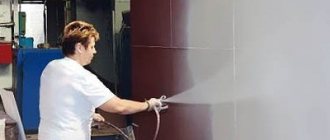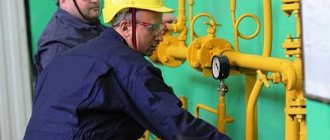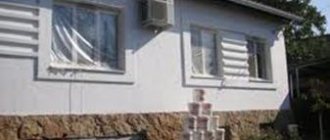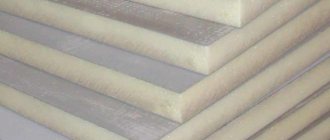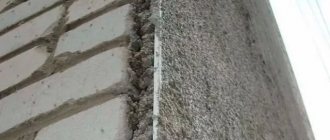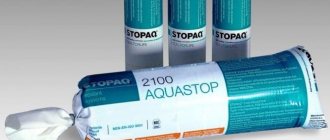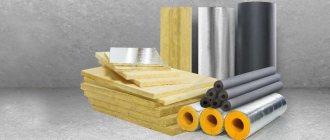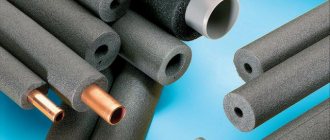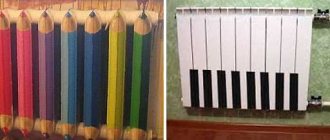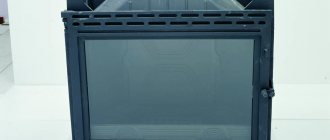Liquid thermal insulation is a modern acrylic or water-based material consisting of hollow ceramic, glass or aluminosilicate microspheres with rarefied air inside, which after the polymerization process forms a dense structure with low thermal conductivity and a high degree of waterproofing.
Liquid thermal insulation was previously used only to cover the skin of the shuttle, but due to its excellent properties, it has become widely used in everyday life when performing construction and repair work for thermal insulation and waterproofing of engineering structures and structures.
Let's look in more detail at why liquid insulation is so popular and what its competitive advantages are over mineral wool, extruded polystyrene foam and polystyrene foam.
Scope of application of liquid thermal insulation
Liquid insulation of this class can be used during construction and installation work (construction and installation works), namely:
- For insulation of floors, walls and roofs;
- To protect the facade from the negative effects of precipitation;
- For waterproofing floors in particularly wet areas (bathrooms, car washes, swimming pools, etc.);
- For thermal insulation of utilities (hot water supply and heating pipelines);
- For sealing interpanel seams in multi-storey panel buildings.
Based on the above list, we can say that liquid thermal insulation can be used in practically all areas, however, sometimes it is recommended to replace this material with an analogue. Let's consider these cases.
What is liquid wall insulation?
In addition to the fact that liquid insulation allows you to apply insulation in a fairly simple way, even after hardening this insulation is a durable monolithic, porous layer. And it performs the role of thermal insulation perfectly. Thanks to its structure, which has many air-filled microspheres, the insulation performs its functions many times better than its analogues. It is believed that just a few millimeters of liquid insulation have the same effect as a 5-7 centimeter layer of conventional insulation, for example, mineral wool, glass wool or polystyrene foam.
On the modern building materials market, various types of liquid insulation are sold, which are better suited for different purposes. The difference between these insulation materials is that they are produced from different raw materials, and the technology for applying the insulation also differs. Here are the varieties:
- Ceramic compositions.
- Expanded polystyrene or penoizol.
- Sprayed ecowool.
Of course, as with any choice of materials, for example, brick, we must understand that each brick is suitable for its own purposes, for example, clinker brick is used for the facade of a house, white sand-lime brick is good for its frost resistance, and fireclay brick is needed when building a fireplace or stove. Liquid insulation is no exception, so each type of insulation has its own pros and cons, and their scope of application also differs.
Where is liquid insulation used?
The scope of application of liquid insulation is quite diverse. This material is used for not only various construction tasks. Often such compounds are used in automotive production to protect metal from corrosion. Liquid insulation is also used for various products that must work by maintaining heat within certain values.
Where is liquid insulation used?
But still, the main area of application of such compositions is construction, namely the insulation of the following parts of the house.
- Stan.
- Paula.
- Floors.
- Ceilings and roof coverings.
- Pipe
In other words, liquid insulation is considered more versatile than any other insulation that we talked about in the last article. This versatility is associated with the method of applying the insulation; it is this that allows the use of liquid insulation where it is simply not possible to use any other.
The main pros and cons of liquid insulation
Liquid insulation has many fans among professional builders. This is due to the fact that such insulation has several undeniable advantages, namely:
- Universal use on surfaces of any configuration.
- The material has high resistance to external physical influences.
- The material has good fire resistance.
But unfortunately, like any material and technology, liquid insulation also has disadvantages that can complicate some work and not perform the necessary functions. The main disadvantage of liquid insulation is precisely its method of application. This is due to the fact that some liquid insulation requires special equipment. This creates the need to contact specialists. This means that it is not always possible to do the work yourself. This means that another expense item will appear. But construction is already a costly business, so some consumers choose more traditional insulation, even despite all the obvious advantages of liquid insulation.
The main advantages of liquid thermal insulation
Since liquid thermal insulation is a relatively new finishing material on the building materials market, quite a few people still know all the main advantages and advantages due to which this insulation is used in almost all areas, gradually replacing the old type of insulation.
Let us consider in more detail the main advantages of this type of thermal insulation.
- When finishing the façade of a building using liquid insulation, the reduction in heating costs can reach 25-30%.
- Due to its structure, liquid insulation completely reflects up to 95% of solar and ultraviolet radiation, thereby ensuring coolness in the room in the summer.
- When covering engineering systems (water supply, ventilation, air conditioning or heating) with an ultra-thin layer of this class of thermal insulation material, condensation does not form on their surface, which causes corrosion.
- DIY application is easy to do using a regular roller, brush or spatula.
- It can be used as an antifungal agent because it does not produce moisture, which is a breeding ground for microorganisms.
- It can serve as waterproofing since liquid thermal insulation does not allow water to pass through at all.
- Effective protection even at ultra-high temperatures (up to 220 C) without loss of physical properties.
- Ideal adhesion to any surface (concrete, brick, plastic, wood, etc.).
Efficiency assessment from experts
Since its inception, liquid thermal insulation has significantly displaced traditional types of insulation in the building materials market. Without being inferior in environmental friendliness, it ensures a reduction in labor costs, consumption of building materials, and has improved characteristics:
- Minimal load on load-bearing structures - a layer of several microns instead of the standard 50 - 20 mm
- Easy to use – painting with a spray gun, roller, brush
- universal in use - treatment of walls, ceilings, the inside of the roof, basements
- Does not require cutting - no trimmings or waste requiring disposal
- Convenient to store and transport - a bucket of paint takes up much less space than a stack of polystyrene foam sheets and can be transported by car or manually
Thermal insulation paint, which you can buy in our store, is available in various packaging, allowing you to choose the right amount to reduce your repair budget. Prices can be viewed on the page of each product.
Situations when additional thermal insulation of an apartment or house is required are quite common.
Warm paints for interior work are an alternative to mineral wool, plasterboard and other materials.
It is impossible to replace all the insulation with paint, but it is possible to reduce heat consumption. Indoors, such thermal paint is used in places with temperature changes, for example, near the wall of a corner room, where condensation forms due to temperature fluctuations. The use of thermal paint allows you to increase heat savings by up to 20%.
Liquid insulation today is just gaining the trust of consumers, but there are already opposing opinions about the effectiveness of using “liquid ceramics”. For example, the calculations are given:
- extruded polystyrene foam in fact (50 mm) costs 300 rubles. (sq. m);
- assume thickness 1mm, price per sq. meter - 6 rubles;
- the total cost in equivalent of ultra-thin thermal insulation is 450 rubles/liter;
- With the recommended consumption of thermal paint, its price is for the same 1 sq. m. (thickness 1 mm) when applied in a single layer is 100 times higher than that of expanded polystyrene.
In contrast to such reasoning, other experts give the example that the thermal insulating properties of the extruded polystyrene foam given as an example are at least 50 times lower, and the surface emissivity due to the roughness of the thermal paint is much higher. When treating the surface with “liquid ceramics”, the effect of a “thermal mirror” is obtained.
Flaws
- In severe frosts, slopes in a panel house completely freeze if applied incorrectly or if the manufacturer's recommendations are not followed.
- When using TSM Ceramics, cracks may appear on the facade of buildings, since this manufacturer simply moves the dew point and does not protect the house from heat loss at all.
- Liquid thermal insulation Izollat, Asstratek is prohibited from being applied to the facade, but can only be used for waterproofing metal structures.
- When water is diluted above the specified standards, the thermal insulation simply flows off the walls.
What are the pitfalls when using liquid thermal insulation for interior and exterior walls?
The thermal conductivity of liquid ceramic insulation for walls of the Mascoat brand (Made in USA) measured using standard methods is 6.98 kW/(m*°K). Thermal conductivity of polystyrene foam is 37-43 kW/(m*°K). The thermal conductivity of liquid insulation coating is 1.5 times higher than that of foam plastic. What are the pitfalls when using liquid thermal insulation for internal partitions:
- The long service life of liquid goods on the packaging is easily divided by 1.5-2.
- The durability of coatings with concrete materials increases if the technology is followed and the material is applied correctly.
- Manufacturers do not provide 100% confirmation of the thermal conductivity guarantee, other than the description in the certificate of conformity. Otherwise, the material will not be allowed for mass use.
- Manufacturers do not indicate in the passport the exact amount of heat retention at a specific layer thickness.
- The high sensitivity of the material to negative temperatures affects the quality of the coating.
The thermal conductivity of liquid insulation coating is 1.5 times higher than that of foam plastic.
Pitfalls in the coating technology for concrete materials:
- Not all materials retain moisture or absorb moisture;
- When air pressure exceeds 0.5 MPa, the supply of liquid materials to the walls forms cracks;
- From a cold warehouse, in winter, with a shelf life of more than 3 months, thermal insulation of the BP series is not suitable;
- High-quality insulation is applied in a layer (1-5 cm), this is an additional consumption of residential goods and the finishing layer;
- The difference between the actual consumption of residential goods and the passport is 2-3 times;
- ZhTI is not suitable for wallpaper or painting, it peels off. “Bronya” is not suitable, the water-repellent properties of which are not suitable for wallpaper glue or paint. The polymer base reacts to paint and adhesives.
For exterior work, there are fewer pitfalls; when finishing the facade, plinth, it is easier to close the residential construction materials except for plastering, painting the HP series:
- Ventilated slabs;
- (SIDING, PVC) panels over liquid thermal insulation.
Not all materials retain moisture or absorb moisture.
Practice shows that you need to listen to the stories of store sellers, and you must check the characteristics against your passport and certificate of conformity. They contain complete information on the properties of the material and reliability indicators. There are many miracles in the world, two real ones: space and a fairy tale, everything else is a bluff. The heat and conservation properties of liquid insulation and thermal insulation are given in the instructions.
Major manufacturers of liquid insulation for buildings (structures) or utility networks
Today, a very large number of manufacturers have begun to produce ultra-thin liquid thermal insulation. However, many of them sell ordinary paint as liquid insulation. How to make the right choice? Let's look at this issue together and present a rating of the most popular manufacturers of this thermal insulation material.
Liquid thermal insulation Astratek
This material is manufactured by the Russian company NPP Termalcom LLC. All products of the concern have appropriate quality certificates and a positive conclusion from the fire service and sanitary and epidemiological station. Liquid insulation Asstratek easily has the consistency of mastic and is easily applied with your own hands to any surface using a roller, sprayer or brush.
- It is not destroyed when exposed to precipitation because it has hydrophobic properties.
- There are no cold bridges, unlike traditional insulation.
- Non-toxic and meets environmental standards.
- Does not support combustion, and is completely safe from fire safety.
- Completely preserves the architecture of the facade and does not steal useful space.
Liquid insulation RE-THERM
The insulation of this class consists of silicone and ceramic microspheres, which are located among a binder based on acrylic and latex. Thanks to this structure, this material has excellent waterproofing properties and, at the same time, high elasticity and particular strength.
The manufacturers of this product promise that the thermal conductivity of 1 mm of RE-THERM liquid insulation corresponds to 5 cm of mineral wool.
- This liquid insulation can be used on various surfaces, from concrete and brick to glass and plastic.
- Demonstrates ideal characteristics in the temperature range from −470 to 250 C.
- Quick drying, which ranges from 3 to 24 hours.
- High resistance to various mechanical influences, as well as to ultraviolet and infrared rays.
- Can be used both outside and inside buildings and structures.
VIOTERM Metal ALLUMA
This type of coating is specially designed for processing metal structures and engineering structures. Thanks to its structure, liquid insulation VIOTERM Metal ALLUMA gives the surface a glossy tint and reliably protects the surface from corrosion.
In addition to the above advantages, this ALLUMA coating perfectly retains heat in hot water supply and heating systems.
- It is used exclusively for treating metal surfaces as waterproofing.
- Demonstrates effectiveness at ambient temperatures from −50 C to 250 C.
- Low consumption, which is only 1 liter per 1 m2 with a layer thickness of 1 mm.
- When insulating water supply systems for hot water supply and heating systems, heat losses are reduced by 30%.
- The service life of this coating is 10-15 years.
Liquid thermal insulation, liquid insulation, thermal insulation paint
— under such names, the construction market offers compounds that, according to sellers, when applied to a wall can serve to insulate a house or apartment. Moreover, a thin layer of paint 1 mm thick, according to them, can replace 5 cm of mineral wool or polystyrene foam due to its heat-saving properties.
Thermal insulation paint is a scam!?
A thin layer of liquid thermal insulation on the wall will not bring significant savings in heating costs, nor will it lead to a noticeable increase in the air temperature in the house or apartment.
On the construction market, many sellers insistently offer to buy heat-insulating paint. Most often, this paint is called something like this: liquid ceramic thin-film thermal insulation coating, or in short - liquid thermal insulation or liquid insulation.
Thermal insulating paint is a suspension of ceramic or glass microspheres (hollow or solid) 10-50 microns in size. mixed with acrylic paint. The paint layer after drying has a thickness of 0.3-0.5 mm. and consists of several layers of microspheres bound with a thin acrylic film.
The product is offered under different trade names.
Sellers claim that this paint is based on the now fashionable nanotechnology for use in space projects, and has exceptional properties. A layer of paint 1 mm thick. in terms of heat-saving properties it supposedly replaces 50 mm. polystyrene foam
They recommend it for insulating anything. They may even show you certificates and other documents. An attentive and meticulous reader will not find in these documents confirmation of the outstanding heat-saving properties of the coating compared to other insulation materials.
Methods of heat transfer in the house
It is known that on planet Earth, thermal energy travels through three physical processes:
- Thermal conductivity
- Thermal radiation
- Convection.
In real environments, these processes occur simultaneously and influence each other. For example, when heat propagates in a porous material, the main heat transfer occurs due to thermal conductivity. But in gas-filled pores, heat also moves by convection and thermal radiation.
Usually the result of the combined action of individual processes is attributed to one of them, the main one. Thus, when heat propagates in a porous material, the influence of secondary processes - convection and thermal radiation in the pores - is taken into account by a corresponding increase in the value of the thermal conductivity coefficient.
In the air, heat is transferred mainly by convection - gas flows, as well as thermal conductivity and thermal radiation. The combined process of convection and thermal conduction of heat is called convective heat transfer.
The transfer of heat between different media, air and the surface of the wall, is called convective heat transfer , or heat transfer by contact.
The amount of heat transfer depends on many factors and is characterized by the heat transfer coefficient, α (W/m2*oK). For example, the value of the heat transfer coefficient between the wall and the air will be different, depending on the direction of heat transfer - from the warm air of the room to the wall or from the wall to the cold outside air.
Thermal radiation is the process of converting heat into radiant energy and transmitting it to the surrounding space.
All bodies constantly emit thermal radiation energy due to the fact that part of the internal energy of the emitting body is converted into the energy of electromagnetic waves.
When radiation energy hits other bodies, it is partially absorbed by them, partially reflected, and partially passes through the body.
Solids emit and absorb energy through their surface , and gases through their volume.
Thermal radiation flux is the amount of radiation energy transferred per unit time through an arbitrary surface. The radiation flux passing through a unit surface area is called the surface radiation flux density .
For bodies with temperatures from minus 50 °C to plus 100 °C, the maximum flux of thermal radiation is in the infrared range of electromagnetic waves (wavelength 5-15 microns).
The only building material that has a high reflectivity in the infrared region of the spectrum is polished metal , which is usually aluminum.
DIY method of applying liquid thermal insulation
To ensure high-quality application of thermal insulation, the following measures must be taken:
- Clean the surface from dust and dirt, rust and old paint.
When cleaning metal surfaces from rust, it is necessary to clean the surface until the appropriate metallic gloss appears using special abrasive attachments on an angle grinder. After this, it is recommended to treat the surface with VD-40 to remove various contaminants.
- Prepare liquid thermal insulation before application.
To do this, it is necessary to dilute a certain amount of thermal insulation material (according to the manufacturer’s information) with distilled water. In most cases, it is recommended to add 3-5% water to liquid insulation.
When stirring liquid thermal insulation using a drill or mixer, the maximum number of revolutions should be in the range from 150 to 200 revolutions per minute. If this number is exceeded, there is a possibility of compromising the integrity of the ceramic microcircuits, due to which the thermal insulation effect is achieved.
- Perform surface treatment before applying thermal insulation
To do this, you need to use an acrylic-based primer, concrete contact, or take a liquid thermal insulation material and dilute it in a 1:2 ratio with distilled water. After this, apply the primer to the surface to be treated using a roller or brush and leave for at least 4 hours for the primer layer to dry.
- Do-it-yourself application of liquid thermal insulation
This stage is performed using a regular brush with natural bristles or using a spray gun. Liquid thermal insulation should be applied in layers, and its thickness should not exceed 0.4-0.5 mm. Complete drying of one layer of thermal insulation occurs after 24 hours, provided that the temperature of the treated surface is not lower than 70 C and the air humidity is not more than 80%.
To achieve maximum effect from thermal insulation, most manufacturers recommend applying the material in at least 3 layers.
When using a spray gun (spray gun) to apply liquid heat-insulating material, the pressure should not exceed 80 Bar, since otherwise the integrity of the ceramic heat-insulating microspheres will be damaged.
Liquid thermal insulation of pipes "Teplotortm" in the housing and communal services sector
DESCRIPTION INSTRUCTIONS FOR USE WORK PERFORMED
Every resident of an apartment building who regularly pays for utilities has the right to expect that his apartment will be warm and hot water will flow from the tap.
But is this really so?
As practice shows, hot water and heating pipes in many basements and attics of apartment buildings heat basements, attics, and the atmosphere, but not apartments, because... they completely or partially lack thermal insulation of the pipes, and if they do have it, it does not fulfill its functions.
All problems with thermal insulation of pipes in apartment buildings will be solved by liquid thermal insulation of pipes "Teplotor TM".
Liquid thermal insulation of pipes has all the necessary certificates, including a Certificate of inclusion in the Register of new technologies, equipment and materials used in the field of housing and communal services and construction of the Russian Federation, as well as a Certificate of Compliance with the norms and rules of technical operation of the housing stock.
Comparative table of the pros and cons of using various pipe insulation materials.
| Characteristics | Min. galvanized plate | PPU with galvanization | PPU with fiberglass | Heattortm |
| Thickness (mm) | 50 | 50 | 50 | 1 |
| Thermal conductivity | 0,035 | 0,033 | 0,033 | 0,001 |
| Wetness of insulation | There is | No | No | No |
| Corrosion under the insulation layer | There is | There is | There is | No |
| Theft of materials | There is | There is | There is | No |
| Environmental Safety | No | There is | There is | There is |
| Scope of repair work | big | big | big | small |
| Service life (years) | 2 | 15 | 15 | 15 |
| Aesthetics | quickly lost | quickly lost | quickly lost | saved |
Liquid thermal insulation of pipes "Teplotor TM"
Instructions for using liquid thermal insulation as a pipeline insulator
Preparation of surfaces for treatment with liquid thermal insulation "Teplotor TM"
Clean the insulated part from dirt, rust and old paint that does not adhere well, using metal brushes.
Be sure to degrease the pipe! When treating metal pipelines with liquid thermal insulation, it is necessary to apply primer.
We use Unicor-M or Kronacryl for these purposes, although any primers can be used.
When applying liquid insulation to galvanized or aluminum surfaces, there is no need to prime.
Information on heat-resistant enamels and primers:
| Name | KO-8104 | CBS 12-03 | CBS 12-01 | KO-870 | KOS 82-03 | KO-811 | KO-8101 | CBS 11-07 | Unikor-M | Cronacryl |
| Heat resistance, degrees | Up to 400 | Up to 150 | Up to 300 | Up to 600 | Up to 600 | Up to 600 | Up to 600 | Up to 300 | Up to 150 | Up to 110 |
Features of liquid ceramic insulation
All known insulating materials (foam plastic, mineral wool and others) have been replaced by others developed using the latest technologies. Given its many advantages, liquid insulation is quickly gaining the trust of consumers.
It necessarily contains balls made of glass, ceramics or polymer, filled with rarefied air. They are bound together with acrylic or latex. Also, for additional functions, other components may be present in the insulation (quartz, titanium dioxide, zinc oxide, additives that prevent corrosion, mold, various fixatives, catalysts).
Depending on the conditions and purposes of use, liquid insulation materials are divided into brands. For example, some are used for external walls, others process pipes (even rusty ones) and metal. Some can only be worked at above-zero temperatures, while others can only be worked at below-zero temperatures.
Coating technology begins with careful surface treatment. Next, the heat insulator is applied several times. The thickness of one layer should often be 0.5 mm (depending on the brand), each of which must be dried (approximately 24 hours).
Liquid ceramic insulation is represented by the following brands:
1. Asstratek. It looks like a homogeneous suspension, which can be applied by spray or brush. The service life is designed for 30 years, the recommended minimum coating thickness is from 3 mm. This material can be used for structures with surface temperatures up to +150 ° C. Withstands a range from -60 to 250 ° C.
The thickness of one layer of liquid insulation should be 0.4 mm. Considering a single-layer application, the consumption of Asstratek per 1.5-2 m 2 is 1 liter. Represented by the brands: Universal, Metal, Facade.
2. Corundum. A homogeneous mass with many advantages is distinguished by a guaranteed service life of up to 15 years, as well as adhesion to almost all materials (plastic, brick, metal, concrete, various equipment). Apply with a brush or machine.
Liquid ceramic insulation Corundum has the following brands: Classic, Anticorrosive, Winter, Facade. Let's take a closer look:
- Classic. The maximum layer thickness is 0.5 mm. Used in the mode from -60 to 250 ° C. Exceeding the thickness of the application entails further difficulty in evaporating moisture.
- Anticorrosive It has anti-corrosion properties. Can be used even on rusty surfaces. Ideal for use as liquid insulation in the garage.
- Winter. The unique composition allows application at low temperatures (down to -10 ° C).
- Facade. The layer thickness is up to 1 mm, specially designed for concrete structures. Due to its properties, it is used as protection of buildings with subsequent decorative coating of walls. Use is permitted in the range from +5 to +150 ° C, can be used as liquid floor insulation.
3. Armor. Presented in the form of a mass resembling paint. Thanks to its composition, Armor has excellent adhesive, anti-corrosion, and thermal insulation properties. Armor brands:
- Classic. Basic insulation used in the mode from -60 to +200 ° C.
- Anticorrosive It has anti-corrosion properties and can be applied even to rusty materials; applying liquid insulation with your own hands is easy to do. To save money, the second and subsequent layers are made by the Classic brand.
- Winter. A distinctive feature is the operating mode: from -35 ° C.
- Facade. Possibility of coating with a layer of up to 1 mm.
4. Akterm. It is distinguished by the inclusion of silicone and ceramic vacuum balls. Externally it looks like thick paint. Akterm brands:
- Standard. Operation at -60 – +260 ° C. It is recommended to coat at +10-50 ° C. Surface temperatures can range from +7 to 80 ° C. Used for pipes, gas pipelines, window frames, steam pipelines, perfectly protects against solar heat and overheating .
- Facade. The base is water. Such liquid insulation materials are suitable for walls made of concrete, plaster, brick, and wood. Operation at -60 – +150 ° C, other characteristics are the same as in the Standard. Prevents fungal formations and freezing.
- North. Distinctive operating conditions: at -30 ° C, humidity – up to 80%. The temperature of the surfaces can fluctuate in the range from -30 to +80 ° C, perfect for harsh winter conditions. Drying time for each layer is at least 24 hours, resistant to alkali.
- Anticorrosive Anti-corrosion liquid insulation, intended for surfaces with temperatures from -30 to +150 ° C, drying time - from 24 hours per layer.
- Akterm NG. Feature – fire safety, completely non-flammable material used as a finishing layer.
- Anti-condensation Prevents condensation on metal pipes, brick, concrete, inside residential premises, operating temperature and walls – +5-40 ° C.
- Volcano. Used at -60 – +450 ° C for reinforced concrete and concrete surfaces, resistant to salts, petroleum products, mineral oils.
Scope of application, pros and cons
“Everything is relative,” said Einstein. Same with waterproofing. There can't be pros without cons. Let's move on to theory and break down all the advantages and disadvantages of liquid waterproofing with deep penetration function.
So, the pros:
- no need to dig up the foundation for processing;
- the solution can be applied with a simple brush like paint;
- the composition modifies concrete: makes it water-repellent, increases strength, frost resistance;
- after treatment, concrete retains its breathable properties;
- no need to dry the surface before applying impregnation;
- the product is safe for humans;
Disadvantages (or rather difficulties) that accompany construction work on applying a penetrating mixture:
- If the wall being treated is no longer new, you need to very carefully clean the surface to free clogged pores. You will need to completely remove the existing coating (plaster and paint).
- For the composition to work, the base must be thoroughly moistened. The solution is applied only on wet concrete. Without this, active additives will not penetrate deep into the pores.
- Large cracks, as well as seams, need to be glued with special paste-like compounds.
- The activity time of the chemical components of the mixture is limited. It is 30 minutes after preparation.
- Work must not be carried out at sub-zero temperatures.
- The drying process also requires compliance with certain conditions. The treated surface is covered with film and periodically moistened for another 2 weeks.
- The coating is not used for brick, cellular concrete, or stone surfaces.
Let us give examples of industrial applications of penetrating compounds to dispel your last doubts. Here's where penetrating waterproofing is used:
- designs of subway structures, tunnels, bridges, thermal power plants, overpasses;
- berths, piers;
- water treatment and hydraulic structures;
- sewerage systems, including settling tanks, ponds, aeration tanks;
- containers for drinking and technical water supply;
- foundations, walls, floors, ceilings of buildings and structures;
- dams, tunnels, mines.
Liquid thermal insulation: application
In this article we will not tell you what good and effective liquid thermal insulation is for walls; on the contrary, we will debunk myths. This insulation, if you can call it that, is only suitable for pipes. Walls, floors, facades can only be painted with it, but not insulated in any way. Are a few millimeters of this nano-new product replaced by 50 mm of foam? No matter how it is, this is impossible, at least with today’s level of technology. This is, at a minimum, a substitution of concepts, and if without banknotes, it is an ordinary deception for the purpose of profit. Alas, these are the realities, everything needs an eye and an eye. Interesting article: Penoizol insulation: application, reviews.
How to properly apply liquid thermal insulation to walls
Application of polyurethane foam is carried out with special units. Polymerization of polyurethane foam occurs after 24 hours. PPU is suitable for brick, concrete, wood, metal, cinder blocks, plasterboard, OSB, gas silicate blocks. The price of construction and installation works is 1000-1500 rubles/m2, layer thickness is 50 mm.
Penoizol is applied under pressure after preliminary mixing of the components, starting to foam. It increases in volume 30 times relative to the loading of the fraction into the mixer. Penoizol foam in a liquid state does not allow use in loaded structures. Other indicators are similar to PPU.
Penoizol is applied under pressure after preliminary mixing of the components, starting to foam.
What is the best method for applying liquid thermal insulation materials?
Liquid insulation for internal walls is applied using mixture supply equipment in 3-5 layers. Each layer is given time to dry and harden. Liquid insulation has advantages with a minimum of disadvantages. Correct adherence to the rules and technology will minimize errors, peeling, and damage to the coating. Machine processing is more efficient and faster in time.
Liquid insulation for internal walls is applied using mixture supply equipment in 3-5 layers.
Common mistakes when applying liquid thermal insulation materials and how to avoid them
When preparing for thermal insulation, builders mistakenly prime the walls with GF type and cover them with PF paints. The materials must not be mixed; they are not compatible with Astratek insulation and other residential products. It is required to use the instructions, follow the technology of thermal insulation coating, and use recommended materials.
It is required to use the instructions, follow the technology of thermal insulation coating, and use recommended materials.
Thermal conductivity characteristics - substitution of concepts
The first characteristic we will consider is the ability to pass steam. There is no deception here, and the manufacturers claim that their product cannot boast of this. Based on this alone, we can conclude that liquid thermal insulation is not suitable for a wooden house. This is a short introduction that should set you in the right mood of healthy skepticism, as it is simply necessary. We are dealing with a large-scale deception that we have to debunk.
The second, most important, characteristic of any insulation is its thermal conductivity. Here manufacturers and sellers voice a simply incredible figure - 0.0012 W/m*S.
The conclusion of NIISF RAASN is that liquid insulation for walls cannot be used as external thermal insulation.
Can you imagine, this should be awarded a Nobel Prize, it’s just a colossal breakthrough in thermal engineering. But, unfortunately, no cash prize has yet been given for the invention of super-efficient liquid thermal insulation for floors: either the recipient did not deign to show up, or there was no breakthrough at all.
What we see in the conclusions of expert institutions:
- thermal conductivity of Asstratek - from 0.053 to 0.082 W/m*C;
- thermal conductivity of Thermo-Shield is from 0.35 to 0.5 W/m*C.
This is not a typo, Thermo-Shield is really 10 times worse than simple polystyrene foam. Things are better with Astratek, but the real 0.082 and the declared 0.0012 are heaven and earth, but according to the law everything is pure, without deception. How so? The usual substitution of concepts. Liquid thermal insulation consists of:
- ceramic vacuum microspheres;
- latex, which acts as a binder.
So, ceramic balls really have very low thermal conductivity, and mastic, which contains all components, has 0.082 W/m*C. It turns out that manufacturers give us true information about the thermal conductivity of only one component, they just don’t specify it, and they probably forget. No matter how much they deceive, but only keep back information, they still mislead people.
Scope of application of heat-insulating paints
This product group cannot be used as facade insulation. One example:
Seams painted with liquid ceramic paint after the heating season
What liquid insulation with ceramic balls is really capable of:
- Good solar reflection (any glossy white paint will do this well)
- Protecting boiler house workers from accidental burns on pipes (the so-called “Toilet paper effect”).
The video below discusses this effect in detail.
Sellers often cite thermograms from thermal imagers as evidence - photos of painted sections of the facade, in which the paint looks like a blue patch against the background of uninsulated parts of the wall. I found a very interesting example of how a thermal imager reacts to colors:
A forum member from Forumhouse painted the wall of his house with beige and white water-based emulsion. I pasted on a couple of pieces of black electrical tape. White, beige and black colors.
How does a thermal imager see colors?
Inappropriate use of liquid thermal insulation
Conclusion of NIIMosstroy based on the results of a study of liquid ceramic coating Korund.
One of the favorite trump cards of sellers is the supposed possibility of using liquid thermal insulation for walls from the inside. At the same time, it is like a panacea against mold. Well, it’s very convenient: take a brush, apply paint in the corners in several layers and that’s it, you can forget about mold, and the house becomes so warm that it’s even hot. We don't want to upset you, but this is not true:
- you need to insulate from the outside, from the inside only as a last resort;
- We have already talked about thermal conductivity, no comments here, there is absolutely no effect;
- does the mold disappear? No matter how it is, she is simply not visible.
Calculated thermal readings of Thermo-Shield.
This heat-insulating paint does not allow moisture to pass through, which condenses at the dew point - this is between the wall and the mastic. Mold lives there and thrives, but you don’t know about it at all - blessed is the one who doesn’t know. In particularly clinical cases, liquid floor insulation is used. As paint it’s great, but as insulation it doesn’t work.
What can we say when the insulation of facades with liquid thermal insulation is presented as a solution to the issue of heat loss once and for all. People believe it, dump the whole house, pay the same amount for heating after the work is done, and go to court in the spring. They have been suing there for years and to no avail, and the money has already been spent, and not a small one. Consumption per meter is 0.5 liters (one layer 0.4 mm). There should be at least 8 layers, which means 4 liters per square meter at a price of 300 rubles per liter. Total 1200 rubles per square meter. For comparison, a cubic meter of polystyrene foam is 50 mm with a density of 25 kg/m. a cube costs 3,500 rubles. A square meter will cost 175 rubles, even with glue and finishing it will be 350 rubles, but not 1200.
A metal pipe for a stainless steel gas boiler chimney must be insulated, unless we are talking about coaxial chimneys. Thermal insulation is only needed in areas that are located in unheated rooms and outdoors.
Here you can read the instructions on how to make a chimney for a gas boiler with your own hands.
Where is it beneficial to use liquid thermal insulation?
Unlike most thermal insulation materials, liquid ceramic thermal insulation coatings work effectively under conditions of low heat transfer from the outer surface.
Heat transfer is heat exchange (convective or radiant) between the surface of a heated solid and the environment.
Heat transfer from a surface strongly depends on what material the surface is in contact with. It is better if this material is air. In addition, heat transfer by radiation or convection is characteristic of highly heated surfaces .
This suggests that a coating of thermal insulating paint can be effectively used as a topcoat for highly heated surfaces.
Liquid ceramic thermal insulation is recommended for effective thermal insulation of “hot” surfaces with temperatures up to 200 ºС. Coating with heat-insulating paint allows you to reduce the temperature of the hot surface to a value that is safe according to sanitary standards (up to 45-55 ºС).
At industrial enterprises, liquid thermal insulation is used for thermal insulation of heat and steam pipelines, boilers, energy facilities, oil storage tanks and other metal structures.
Attempts by sellers and manufacturers to force buyers to use liquid thermal insulation to insulate walls, facades, and ceilings in a house, claiming that a thin layer of paint replaces traditional insulation, is a deception .
The use of thermal insulation paint in the household
It is advantageous to use coatings made from thermal insulation paint where applying a thin layer of thermal insulation is sufficient to achieve the desired result.
For example, liquid thermal insulation applied to steel water pipes will help prevent condensation from appearing on their surface and protect the pipes from corrosion.
It is known that in winter the surface temperature of the outer wall is always lower than the air temperature in the room. To increase thermal comfort, it is often enough to increase the surface temperature of the outer wall or ceiling by literally a few degrees from the room side. Application of liquid thermal insulation with a thickness of 1-2.5 mm to the inner surface. often enough to eliminate freezing of a window slope, wall or ceiling, eliminate condensation and mold on their surface.
Liquid thermal insulation can be easily tinted in any color; wallpaper can be glued to the paint layer.
Liquid insulation, as a rule, has to be applied in several layers. Considering the fairly high cost of the material , its use in the household, in the above cases, is beneficial if the coverage area is small.
Promotional video from one of the manufacturers of liquid thermal insulation:
The effect is impressive! You need to take the paint! Is it true?
Please note that the announcer in the video reports the thickness of the liquid thermal insulation: 3 mm. And this is approximately 6 layers of paint!
At the end of the video, the announcer makes a conclusion about the remarkable “fire-retardant” and “heat-saving” properties of liquid thermal insulation.
Each of us did a similar experiment when we picked up a hot frying pan through a rag. But I have never heard anyone claim that the rag is 1 mm thick. in terms of heat-saving properties, it is equivalent to 50 mm. foam!
In all of these experiments, with ice and a frying pan, the heat transfer process is influenced by a combination of thermal conductivity, heat capacity and density of the materials used.
Above in the article, as an example, the thermal conductivity value of liquid thermal insulation from one of the manufacturers is indicated (0.0698 W/(m*°K)). The thermal conductivity of liquid thermal insulation is greater than that of traditional insulation (0.043 W/(m*°K)). For this reason, a thin layer of liquid insulation cannot replace a 50 mm layer. mineral wool or polystyrene foam.
Please note that the above thermal conductivity of liquid thermal insulation was determined using standard methods . The fact is that manufacturers of thermal insulation paint in advertising documents often indicate a wonderfully low thermal conductivity value, which is determined by calculation. For example, in the documents I came across a calculated thermal conductivity coefficient for liquid thermal insulation of 0.0012 W/(m*°C). Buyers usually do not pay attention to this difference in methods. This circumstance allows sellers to mislead buyers. Compare thermal conductivity indicators using different methods and claim that paint is 50 times more effective than foam plastic.
To save heat in the house and reduce heating costs, it is more profitable, efficient and reliable to insulate the wall using one of the traditional methods - a layer of mineral wool or polymer foam insulation.
We were able to find test results of the thermal insulation properties of paint from one well-known brand. The paint was applied to a sheet of drywall and determined how the coating changed the thermal conductivity of the sheet. The results indicate that at room temperature a layer of such paint is 1 mm thick. can only replace 1.6 mm. polystyrene foam
More articles on this topic:
⇒ Insulation from the inside of the walls of a house, apartment, loggia, balcony
⇆
More articles on this topic
- Bearing capacity of soils at the base of the foundations of a private house
- We are building a wood-burning house with walls made of firewood - logs
- Apartment redevelopment - fresh ideas
- Floors on the ground on the first floor of a private house without a basement
- How to make an entrance vestibule in a private house
- Films and membranes for water vapor barrier and wind protection at home
- Heating costs and heat transfer resistance
- Air humidifier for apartments and houses - which one is better to choose?
